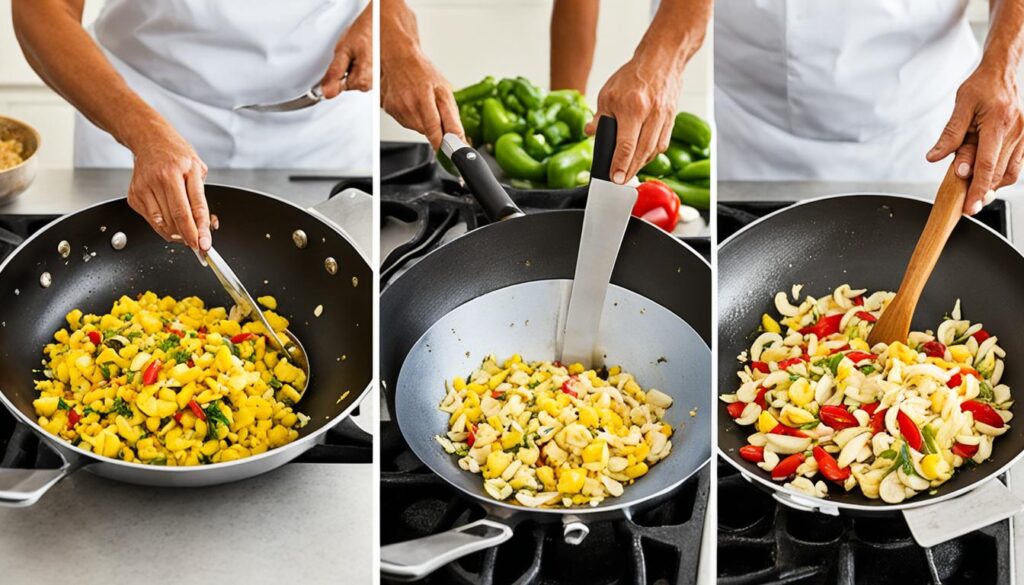Did you know that ackee and saltfish is the national dish of Jamaica, enjoyed by millions across the island and around the world? This vibrant blend of Jamaica’s exotic ackee fruit and savory salted codfish embodies the rich culinary heritage of the Caribbean nation, celebrating its diverse cultural influences. The creamy, mild-flavored ackee fruit perfectly complements the salty, flaky codfish, creating a harmonious balance of textures and flavors that has captivated palates far and wide.
Ackee and saltfish is not just a meal – it’s a cherished part of Jamaica’s food culture, enjoyed for breakfast, lunch, or dinner, and often paired with traditional staples like fried plantains, boiled dumplings, and roasted breadfruit. This iconic national dish is a reflection of our island’s history, from the indigenous Taino people to the African, Spanish, and British colonial traditions that have shaped our culinary landscape.
Unveiling Jamaica’s Iconic National Dish
The origins of ackee and saltfish, Jamaica’s beloved national dish, can be traced back to the intersection of the island’s diverse cultural influences. The ackee fruit, which is the central ingredient in this iconic dish, is believed to have been introduced to Jamaica by the West African slaves during the era of the transatlantic slave trade. The saltfish, typically salted codfish, was a staple food brought by the European colonizers, particularly the Spanish and British. Over time, these two distinct ingredients were combined and transformed into the quintessential Jamaican national dish that we know and love today.
The Origins of Ackee and Saltfish
The origins of ackee and saltfish can be traced back to the jamaica food history and the caribbean cuisine history. The dish is a reflection of the island’s rich cultural heritage, blending the culinary traditions of the indigenous Taino people, the African, Spanish, and British colonial influences. This iconic Jamaican dish has become a treasured part of the jamaican cuisine and is enjoyed by locals and visitors alike.
Ackee: The Exotic Fruit at the Heart of the Dish
At the heart of the ackee and saltfish dish is the ackee fruit, a unique and exotic ingredient that has become synonymous with Jamaican national dish. The ackee fruit was introduced to the island by the West African slaves during the transatlantic slave trade, and it has since become an integral part of the jamaican food culture.
Saltfish: The Savory Counterpart
The savory counterpart to the ackee fruit in this iconic dish is the saltfish, typically salted codfish. The saltfish was a staple food brought to Jamaica by the European colonizers, particularly the Spanish and British. The combination of the ackee fruit and the saltfish creates a harmonious balance of flavors and textures that has made ackee and saltfish a beloved jamaican national dish.
Exploring the Flavors of Ackee and Saltfish
The preparation of ackee and saltfish is a time-honored tradition in Jamaican cuisine, with many families passing down their unique recipes from generation to generation. The traditional method involves soaking and boiling the salted codfish to remove excess salt, then sautéing it with the cleaned and prepared ackee, along with a blend of aromatic ingredients like onions, Scotch bonnet peppers, tomatoes, and spices like black pepper and allspice.
Traditional Preparation Methods
Our Jamaican cooking techniques for ackee and saltfish are deeply rooted in the island’s rich culinary heritage. The process begins with carefully selecting and preparing the ackee fruit, removing any discolored or damaged parts to ensure the dish’s signature creaminess and flavor. The salted codfish is then soaked and boiled, a crucial step that removes the excess salt and allows the fish to become tender and flaky.
Regional Variations and Twists
While the classic ackee and saltfish recipe remains a beloved staple, regional variations and creative twists have emerged across the Jamaican cuisine landscape. Some families may incorporate additional ingredients like pumpkin, carrots, or bell peppers to add vibrant colors and distinctive flavors to the dish. Others may experiment with different seasonings, such as the addition of thyme, garlic, or even a splash of coconut milk, to elevate the ackee and saltfish preparation and showcase the flavors of Jamaican cuisine.

The Ackee and Saltfish Experience
Enjoying ackee and saltfish is more than just a culinary experience – it’s a cultural immersion that invites us to savor the vibrant flavors and traditions of Jamaica. This iconic dish is often served as part of a larger Jamaican breakfast, accompanied by a variety of complementary dishes and sides that showcase the island’s diverse culinary heritage.
Pairing Ackee and Saltfish with Other Jamaican Delights
When savoring ackee and saltfish, we often pair it with classic Jamaican breakfast items like fried plantains, boiled dumplings, and roasted breadfruit. The creamy, mild-flavored ackee and the salty, flaky saltfish create a harmonious balance that is perfectly complemented by the starchy, sweet, and earthy notes of these traditional side dishes. Together, they form a truly authentic Jamaican breakfast experience that celebrates the island’s rich culinary tapestry.
Serving Suggestions and Presentation Tips
Ackee and saltfish is often served in a simple yet elegant manner, allowing the vibrant colors and enticing aromas to take center stage. The dish is typically presented on a plate, with the ackee and saltfish mixture neatly arranged and garnished with fresh herbs, such as thyme or scallions. For a visually appealing presentation, we may also include sliced tomatoes, onions, and a drizzle of olive oil or a sprinkling of freshly ground black pepper. Serving ackee and saltfish alongside warm, freshly baked Jamaican hard dough bread or festival (fried dumplings) can further enhance the overall dining experience and transport us to the heart of Jamaican cuisine.
